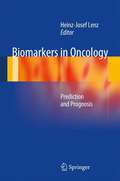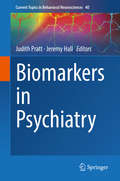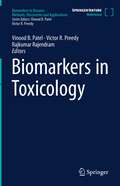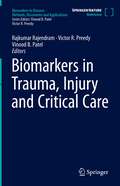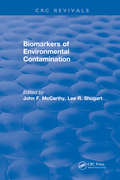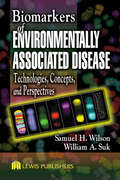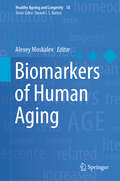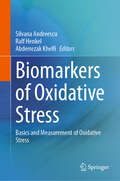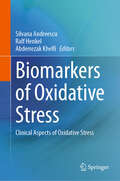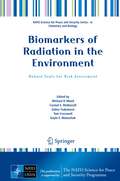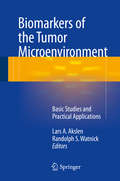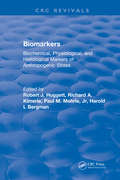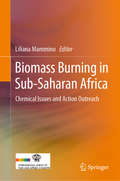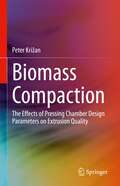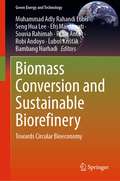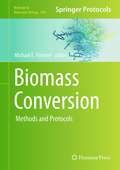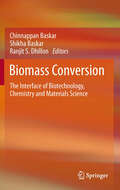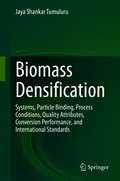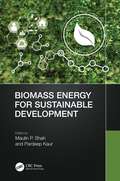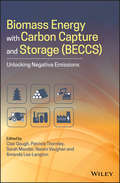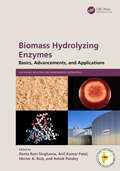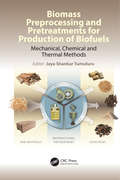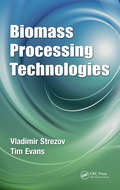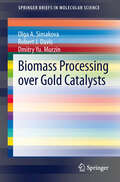- Table View
- List View
Biomarkers in Oncology
by Heinz-Josef LenzThis integrated book covers the entire spectrum of cancer biomarkers in development and clinical use. Predictive and prognostic markers are explored in the context of colon cancer, breast cancer, lung cancer, prostate cancer, and GIST. International experts provide insight into toxicity markers and surrogate markers. Attention is also given to biomarker assay development, validation, and strategies. A powerful tool for determining decisions on therapy, selecting drug regimens, monitoring the efficacy of treatment, and performing individualized surveillance, biomarkers represent the forefront of cancer research and treatment. As these technologies become increasingly available for clinical use, this book will be an essential resource for oncologists and translational researchers.
Biomarkers in Psychiatry (Current Topics in Behavioral Neurosciences #40)
by Judith Pratt Jeremy HallThis volume addresses one of the Holy Grails in Psychiatry, namely the evidence for and potential to adopt ‘Biomarkers’ for prevention, diagnosis, and treatment responses in mental health conditions. It meshes together state of the art research from international renowned pre-clinical and clinical scientists to illustrate how the fields of anxiety disorders, depression, psychotic disorders, and autism spectrum disorder have advanced in recent years.
Biomarkers in Toxicology (Biomarkers in Disease: Methods, Discoveries and Applications)
by Victor R. Preedy Vinood B. Patel Rajkumar RajendramThis handbook of the series Biomarkers in Disease informs comprehensively about all aspects of monitoring and detecting toxicity in the human body and model organisms. Biomarkers for assessing toxicity in diverse organs are presented and different assays and methods are explained. Single compounds and drugs and their toxicity for humans are shown and the methods for detection described. Similar to all the volumes of the Biomarkers in Disease series, the chapters are written by experts in their field, each chapter features key facts summarizing the most important aspects of its respective topic and the definitions of words and terms facilitate the reading and understanding. This handbook is a must-have for researchers in toxicology and biomedicine who analyze the effects of drugs and various other substances in the human body and in model organisms. It also serves as a thorough guide for clinicians and pharmacologists.
Biomarkers in Trauma, Injury and Critical Care (Biomarkers in Disease: Methods, Discoveries and Applications)
by Victor R. Preedy Vinood B. Patel Rajkumar RajendramThis handbook systematically presents biomarkers for traumatic injuries. The book covers topics such as traumatic brain injury, liver injury, burn severity, muscle heart damage, and acute inflammation in polytrauma and their detection by biomarkers.Biomarkers and methods used in critical care and critically ill patients are discussed, as well as biomarkers in trauma and special conditions. Specific biomarker components are explained and models for modeling trauma in research are presented.This systematic handbook is an excellent resource for researchers and specialists in trauma research and treatment, as well as clinicians and physicians who want a thorough overview of various injuries, trauma, and their detection methods.
Biomarkers of Environmental Contamination
by 0 McCarthyHow can biological markers help assess and predict human health risks? Find out the answers to this question and others in this timely new book examining the use of biological markers in animals and plants for evaluating the ecological and health effects of environmental contamination. The book explains the concept of environmental sentinels, presents example of field studies and discusses the utility of biomarkers within a risk analysis paradigm. Anyone who needs to know how to assess and predict environmental contamination should consider this book essential reading.
Biomarkers of Environmentally Associated Disease: Technologies, Concepts, and Perspectives
by William A. Suk Samuel H. WilsonThe end of the 20th century brought with it a revolution in molecular biology that culminated in advances such as the completion of the human genome. This has brought optimism to the fields of toxicology and environmental health, and the anticipation that molecular biomarkers might soon come of age and have a major impact on human and environmental
Biomarkers of Human Aging (Healthy Ageing and Longevity #10)
by Alexey MoskalevThis book collects and reviews, for the first time, a wide range of advances in the area of human aging biomarkers. This accumulated data allows researchers to assess the rate of aging processes in various organs and systems, and to individually monitor the effectiveness of therapies intended to slow aging. In an introductory chapter, the editor defines biomarkers of aging as molecular, cellular and physiological parameters that demonstrate reproducible changes - quantitative or qualitative - with age. The introduction recounts a study which aimed to create a universal model of biological age, whose most predictive parameters were albumin and alkaline phosphatase (indication liver function), glucose (metabolic syndrome), erythrocytes (respiratory function) and urea (renal function). The book goes on to describe DNA methylation, known as the “epigenetic clock,” as currently the most comprehensive predictor of total mortality. It is also useful for predicting mortality from cancer and cardiovascular diseases, and for analyzing the effects of lifestyle factors including diet, exercise, and education. Individual contributions draw additional insight from research on genetics and epigenetic aging markers, and immunosenescence and inflammaging markers. A concluding chapter outlines the challenge of integrating of biological and clinical markers of aging. Biomarkers of Human Aging is written for professionals and practitioners engaged in the study of aging, and will be useful to both advanced students and researchers.
Biomarkers of Oxidative Stress: Basics and Measurement of Oxidative Stress
by Ralf Henkel Silvana Andreescu Abderrezak KhelfiThis book pinpoints one of the fastest growing, complex subjects in chemistry and medical science: the dangers of oxidative stress to human beings. It provides a solid background on the chemistry behind the generation of reactive species as well as how reactive species are involved in essential physiological processes and in almost every human disease. It also covers the most recent developments in the study of oxidative and reductive stress (redox stress), including the role of radical and reactive species, novel antioxidant therapies, and methods for assessing free radicals and redox stress. The chapters present concise, yet thorough, summaries of the state-of-the-art methods and techniques that any investigator working in the oxidative/reductive stress field needs to access. The current methodologies including the development of sensors and biosensors for the detection of ROS/RNS/RHS and of biomarkers of redox stress are thoroughly discussed. This book is a useful resource for all researchers and students interested in oxidative stress, molecular biology, and chemistry. Physicians and healthcare professionals interested in understanding the molecular mechanisms underlying the redox stress-related diseases also stand to benefit from this book.
Biomarkers of Oxidative Stress: Clinical Aspects of Oxidative Stress
by Ralf Henkel Silvana Andreescu Abderrezak KhelfiThis book pinpoints one of the fastest growing, complex subjects in chemistry and medical science: the dangers of oxidative stress to human beings. It provides a solid background on the chemistry behind the generation of reactive species as well as how reactive species are involved in essential physiological processes and in almost every human disease. It also covers the most recent developments in the study of oxidative and reductive stress (redox stress), including the role of radical and reactive species, novel antioxidant therapies, and methods for assessing free radicals and redox stress. The chapters present concise, yet thorough, summaries of the state-of-the-art methods and techniques that any investigator working in the oxidative/reductive stress field needs to access. The current methodologies including the development of sensors and biosensors for the detection of ROS/RNS/RHS and of biomarkers of redox stress are thoroughly discussed. This book is a useful resource for all researchers and students interested in oxidative stress, molecular biology, and chemistry. Physicians and healthcare professionals interested in understanding the molecular mechanisms underlying the redox stress-related diseases also stand to benefit from this book.
Biomarkers of Radiation in the Environment: Robust Tools for Risk Assessment (NATO Science for Peace and Security Series A: Chemistry and Biology)
by Gayle E. Woloschak Michael D. Wood Carmel E. Mothersill Gohar Tsakanova Tom CresswellThis proceedings volume results from the NATO Advanced Research Workshop on 'Biomarkers of Radiation in the Environment: Robust Tools for Risk Assessment (BRITE)’. The BRITE workshop discussed insights from cancer research, epigenetics, non-human and human risk assessment, since many of the state-of-the-art biomarkers being developed for humans deserve consideration for environmental applications and vice versa. Sessions were very wide-ranging covering methods, mechanisms, cross disciplinary application and regulation.The chapters in this book have been grouped into five major themes that were covered by the BRITE workshop:· Techniques for biomarker development· Low-dose effect mechanisms· Biomarkers for risk evaluation· Biomarkers in wildlife· Biomarker use and responses Each chapter has been written independently and reflects the views of the chapter author(s). Therefore, the readers can form their own balanced view of the different perspectives on biomarkers of radiation in the environment. Given the breadth of topics covered and the state-of-the-art perspectives shared by leading experts in their respective fields, this book should form a valuable resource for anyone with an interest in how biomarkers can be used to improve our understanding of radiation in the environment and its potential impacts.
Biomarkers of the Tumor Microenvironment: Basic Studies and Practical Applications
by Lars A. Akslen Randolph S. WatnickThis book reviews different aspects of the cancer microenvironment, and its regulation and importance for tumor progression. Practical applications, in terms of how biomarkers are increasingly included in therapy protocols, will also be discussed. Biomarkers of the Tumour Microenvironment: Basic Studies and Practical Applications is aimed at research pathologists in the cancer field, and also cancer researchers from other backgrounds, especially those using morphology techniques and models focusing on cross-talk between different cell types in tumors.
Biomarkers: Biochemical, Physiological, and Histological Markers of Anthropogenic Stress
by Robert J HuggettThis book provides a survey of biochemical, physiological and histological biomarkers of environmental stress, along with evaluations of the strengths and weaknesses of various techniques for different applications. It features in-depth coverage of such topics as DNA adducts, acetylcholinesterase, ATP, endocrine mechanisms, blood chemistry, histopathological biomarkers, stress proteins, foreign and endogenous metabolites, metallothioneins, to name only a few.The book will be especially useful to toxicologists, biochemists, histologists, immunologists, risk analysis specialists, environmental managers, regulators, environmental scientists and engineers.
Biomarkers: Medical and Workplace Applications
by Mortimer L. Mendelsohn Lawrence C. Mohr John P. PeetersA 38-year-old man who works in a factory applying coatings reports progressive breathing difficulties. A 45-year-old woman attributes her cough to copier "fumes."What are the prospects that compound-specific or diagnostically useful biomarkers can be developed and used for the benefit of workers like these and their employers? What promise do biomarkers of susceptibility offer for reducing risk to occupational exposures? What are the legal and ethical issues associated with the use of such biomarkers?These questions are explored in detail in this volume, which provides a comprehensive report on current and anticipated development in the application of biomarkers.Leading investigators present data, provide expert analyses, and make recommendations in the areas of: Dosimetry and physical measurement of exposure.Use of chromosome aberrations, adducts, and gene mutations as measurement of exposure and response.Metabolic susceptibility.Organ- and system-specific biomarkers.What biomarkers may reveal about carcinogenesis. The book also explores the societal and ethical issues of using biomarkers in the workplace, military, courtroom, and other settings.
Biomass Burning in Sub-Saharan Africa: Chemical Issues and Action Outreach
by Liliana MamminoThis book offers a comprehensive overview of the various aspects involved in biomass burning, highlighting the complexity of the phenomenon and the ensuing challenges for the design of approaches aimed at reducing fires in the open air. Chemical issues are discussed in the first 7 chapters, providing the core of the scientific and technical information. In the then following chapters, experts in the human sciences provide information on people’s attitudes and perceptions. Both types of expertise are needed in the design of interventions that can motivate people and communities to opt for sustainable practices. In closing, the book underscores the importance of pursuing an interdisciplinary approach in order to tackle the problem effectively. It offers a valuable resource for undergraduates, graduates, and policymakers working in the fields of chemistry, environmental science, science education and sustainability.
Biomass Compaction: The Effects of Pressing Chamber Design Parameters on Extrusion Quality
by Peter KrižanThis book discusses the scientific process of biomass compaction, focusing on pressing chamber parameters and their influence on the quality of extrusions from biomass. It yields new knowledge in the field of wood biomass pressing technology and contains a thorough and detailed theoretical analysis of the pressing chamber of pressing machines and the influence they have on the resulting quality of extrusions. Coverage includes the proposal and evaluation of experimental research dealing with the definition of different pressing chamber parameters in pressing machines and their effects on the quality of extrusions; definition and specification of the dependencies of chamber parameters based on the resulting quality of extrusion, given by the mechanical indicators of quality, are also explored. Furthermore, the work describes the design and manufacture of an experimental pressing stand, which allows for experiments to be performed determining the effects that some technological, material, and construction parameters have on the resulting quality of extrusions. The desired pressing method, length, and conicity of the pressing chamber are experimentally determined through the uniaxial compaction of wood biomass where results and dependencies are expressed graphically.Biomass Compaction: The Effects of Pressing Chamber Design Parameters on Extrusion Quality will be a welcomed resource for researchers and engineers working for producers of solid biofuels from biomass, densification (briquetting, pelleting), or compacting machines producers, as well as technology plant operators and those working in the biomass treatment area.
Biomass Conversion and Sustainable Biorefinery: Towards Circular Bioeconomy (Green Energy and Technology)
by Seng Hua Lee Petar Antov Ľuboš Krišťák Muhammad Adly Rahandi Lubis Efri Mardawati Souvia Rahimah Robi Andoyo Bambang NurhadiThis book highlights recent progress on the advancements toward optimization of major biorefinery processes, including biomass pretreatment and fractionation, saccharification of sugars, and conversion of sugars and lignin into fuels and chemical precursors. The continual improvement of these processes and their integration in the format of a modern biorefinery is paving the way for a sustainable bio-economy that will displace large portions of petroleum-derived fuels and chemicals with renewable substitutes. Written by leading researchers from academia and well-renowned industry professionals, this book provides a comprehensive review of various aspects related to the recent developments in biomass conversion and biorefinery, aimed at successfully implementing the circular economy principles in various industries.
Biomass Conversion: Methods and Protocols (Methods in Molecular Biology #908)
by Michael E. HimmelBiomass conversion research is a combination of basic science, applied science, and engineering testing and analysis. Conversion science includes the initial treatment (called pre-treatment) of the feedstock to render it more amenable to enzyme action, enzymatic saccharification, and finally product formation by microbiological or chemical processes. In Biomass Conversion: Methods and Protocols, expert researchers in the field detail methods which are now commonly used to study biomass conversion. These methods include Biomass Feedstocks and Cellulose, Plant Cell Wall Degrading Enzymes and Microorganisms, and Lignins and Hemicelluloses. Written in the highly successful Methods in Molecular BiologyTM series format, the chapters include the kind of detailed description and implementation advice that is crucial for getting informed, reproducible results in the laboratory.
Biomass Conversion: The Interface of Biotechnology, Chemistry and Materials Science
by Ranjit S. Dhillon Shikha Baskar Chinnappan BaskarThe consumption of petroleum has surged during the 20th century, at least partially because of the rise of the automobile industry. Today, fossil fuels such as coal, oil, and natural gas provide more than three quarters of the world's energy. Unfortunately, the growing demand for fossil fuel resources comes at a time of diminishing reserves of these nonrenewable resources. The worldwide reserves of oil are sufficient to supply energy and chemicals for only about another 40 years, causing widening concerns about rising oil prices. The use of biomass to produce energy is only one form of renewable energy that can be utilized to reduce the impact of energy production and use on the global environment. Biomass can be converted into three main products such as energy, biofuels and fine chemicals using a number of different processes. Today, it is a great challenge for researchers to find new environmentally benign methodology for biomass conversion, which are industrially profitable as well. This book focuses on the conversion of biomass to biofuels, bioenergy and fine chemicals with the interface of biotechnology, microbiology, chemistry and materials science. An international scientific authorship summarizes the state-of-the-art of the current research and gives an outlook on future developments.
Biomass Densification: Systems, Particle Binding, Process Conditions, Quality Attributes, Conversion Performance, and International Standards
by Jaya Shankar TumuluruThis monograph discusses the various biomass feedstocks currently available for biofuels production, and mechanical preprocessing technologies to reduce the feedstock variability for biofuels applications. Variability in the properties of biomass—in terms of moisture, particle size distribution, and low-density—results in storage, transportation, handling, and feeding issues. Currently, biorefineries face serious particle bridging issues, uneven discharge, jamming of equipment, and transportation problems. These issues must be solved in order for smooth operations to be possible. Mechanical preprocessing technologies, such as size reduction, densification, and moisture management using drying and dewatering, can help to overcome these issues. Many densification systems exist that will assist in converting low-density biomass to a high-density commodity type feedstock. In 6 chapters, the impact of densification process variables, such as temperature, pressure, moisture, etc., on biomass particle agglomeration, the quality of the densified products, and the overall energy consumption of the process are discussed, as are the various compression models for powders that can be used for biomass particles agglomeration behavior and optimization of the densification process using statistical and evolutionary methods. The suitability of these densified products for biochemical and thermochemical conversion pathways is also discussed, as well as the various international standards (CEN and ISO) they must adhere to. The author has worked on biomass preprocessing at Idaho National Laboratory for the last ten years. He is the principal investigator for the U.S. Department of Energy Bioenergy Technologies Office-funded “Biomass Size Reduction and Densification” project. He has developed preprocessing technologies to reduce cost and improve quality. The author has published many papers and books focused on biomass preprocessing and pretreatments. Biomass process engineers and biorefinery managers can benefit from this book. Students in chemical, mechanical, biological, and environmental engineering can also use the book to understand preprocessing technologies, which greatly assist in improving the biomass critical material attributes. The book can help policymakers and energy systems planners to understand the biomass properties limitations and technologies to overcome the same.
Biomass Energy for Sustainable Development
by Maulin P. Shah Pardeep KaurThe potential future fluctuations in energy security and potential climate change impacts require an emphasis on clean and renewable energies to safeguard the environment as well as economic livelihoods. The current recalcitrant nature of biomass processing has led researchers to find the most suitable technique for its depolymerization, as well as various strategies to pretreat the biomass which include physical, thermochemical, and biochemical methods and a combination of these. Biomass Energy for Sustainable Development examines how optimal biomass utilization can reduce forest management costs, help mitigate climate change, reduce risks to life and property, and help provide a secure, competitive energy source into the future.Features: Provides a comprehensive review of biomass energy and focuses on in-depth understanding of various strategies to pretreat biomass including physical, chemical, and biological Explores multidisciplinary, novel approaches including AI for furthering the understanding and generation of models, theories, and processes in the field of bioenergy Covers the sustainable development goals for bioenergy, including the related concepts of bioeconomy and the potential environmental impact from reliance on bioenergy
Biomass Energy with Carbon Capture and Storage (BECCS): Unlocking Negative Emissions
by Naomi Vaughan Clair Gough Patricia Thornley Sarah Mander Amanda Lea-LangtonAn essential resource for understanding the potential role for biomass energy with carbon capture and storage in addressing climate change Biomass Energy with Carbon Capture and Storage (BECCS) offers a comprehensive review of the characteristics of BECCS technologies in relation to its various applications. The authors — a team of expert professionals — bring together in one volume the technical, scientific, social, economic and governance issues relating to the potential deployment of BECCS as a key approach to climate change mitigation. The text contains information on the current and future opportunities and constraints for biomass energy, explores the technologies involved in BECCS systems and the performance characteristics of a variety of technical systems. In addition, the text includes an examination of the role of BECCS in climate change mitigation, carbon accounting across the supply chain and policy frameworks. The authors also offer a review of the social and ethical aspects as well as the costs and economics of BECCS. This important text: Reveals the role BECCS could play in the transition to a low-carbon economy Discusses the wide variety of technical and non-technical constraints of BECCS Presents the basics of biomass energy systems Reviews the technical and engineering issues pertinent to BECCS Explores the societal implications of BECCS systems Written for academics and research professionals, Biomass Energy with Carbon Capture and Storage (BECCS) brings together in one volume the issues surrounding BECCS in an accessible and authoritative manner.
Biomass Hydrolyzing Enzymes: Basics, Advancements, and Applications (Sustainable Industrial and Environmental Bioprocesses)
by Reeta Rani Singhania, Anil Kumar Patel, Héctor A. Ruiz, Ashok PandeyThis reference book provides advanced knowledge about lignocellulosic biomass production and its application in biomass hydrolysis. Lignocellulosic biomass is the most abundant, ubiquitous, and renewable raw material in the world. Though biomass can be deconstructed by other means, biological ways through enzymes are eco-friendly and sustainable. Biomass Hydrolyzing Enzymes: Basics, Advancements, and Applications discusses the different enzymes used for degrading biomass into its monomeric components. It covers important topics like biorefineries, hydrolysis of algal mass, kinetic modelling for hydrolysis, inhibitory effects, and more.Key Features Highlights recent developments in biorefineries, specific enzymes, inhibitor tolerance, and enhanced efficiencies Provides details on various kinds of biomass hydrolysis including algal biomass Includes the best practices for getting economic and efficient high conversions of biomass Covers strategies to be adopted for increasing the production of highly efficient enzymes Explores the advancements in lignocellulosic biomass hydrolysis The book is suitable for researchers and students in biotechnology, applied microbiology, and environmental sciences.
Biomass Preprocessing and Pretreatments for Production of Biofuels: Mechanical, Chemical and Thermal Methods
by Jaya Shankar TumuluruEngineering the physical, chemical, and energy properties of lignocellulosic biomass is important to produce high-quality consistent feedstocks with reduced variability for biofuels production. The emphasis of this book will be the beneficial impacts that mechanical, chemical, and thermal preprocessing methods can have on lignocellulosic biomass quality attributes or specifications for solid and liquid biofuels and biopower production technologies. "Preprocessing" refers to treatments that can occur at a distance from conversion and result in an intermediate with added value, with improved conversion performance and efficiency. This book explores the effects of mechanical, chemical, and thermal preprocessing methods on lignocellulosic biomass physical properties and chemical composition and their suitability for biofuels production. For example, biomass mechanical preprocessing methods like size reduction (which impacts the particle size and distribution) and densification (density and size and shape) are important for feedstocks to meet the quality requirements for both biochemical and thermochemical conversion methods like enzymatic conversion, gasification, and pyrolysis process. Thermal preprocessing methods like drying, deep drying, torrefaction, steam explosion, hydrothermal carbonization, and hydrothermal liquefaction effect feedstock's proximate, ultimate and energy property, making biomass suitable for both solid and liquid fuel production. Chemical preprocessing which includes washing, leaching, acid, alkali, and ammonia fiber explosion that can enable biochemical composition, such as modification of lignin and hemicellulose, and impacts the enzymatic conversion application for liquid fuels production. This book also explores the integration of these preprocessing technologies to achieve desired lignocellulosic biomass quality attributes for biofuels production.
Biomass Processing Technologies
by Ian MuehlenhausThis book is a thoroughly up-to-date treatment of all the available technologies for biomass conversion. Each chapter looks at the viability and implementation of each technology with examples of existing equipment and plants. In addition, the text addresses the economics of biomass processing. The book could also be used as a supplementary text for senior undergraduate courses on biomass processing.
Biomass Processing over Gold Catalysts (SpringerBriefs in Molecular Science)
by Robert J. Davis Olga A. Simakova Dmitry Yu MurzinThe book describes the valorization of biomass-derived compounds over gold catalysts. Since biomass is a rich renewable feedstock for diverse platform molecules, including those currently derived from petroleum, the interest in various transformation routes has become intense. Catalytic conversion of biomass is one of the main approaches to improving the economic viability of biorefineries. In addition, Gold catalysts were found to have outstanding activity and selectivity in many key reactions. This book collects information about transformations of the most promising and important compounds derived from cellulose, hemicelluloses, and woody biomass extractives. Since gold catalysts possess high stability under oxidative conditions, selective oxidation reactions were discussed more thoroughly than other critical reactions such as partial hydrogenation, acetalization, and isomerization. The influence of reaction conditions, the role of the catalyst, and the advantages and disadvantages of using gold are presented for all of the reactions mentioned above. This book provides an overview of the recent research results focusing on application of gold catalysts for synthesis of valuable chemicals using renewable feedstocks.
